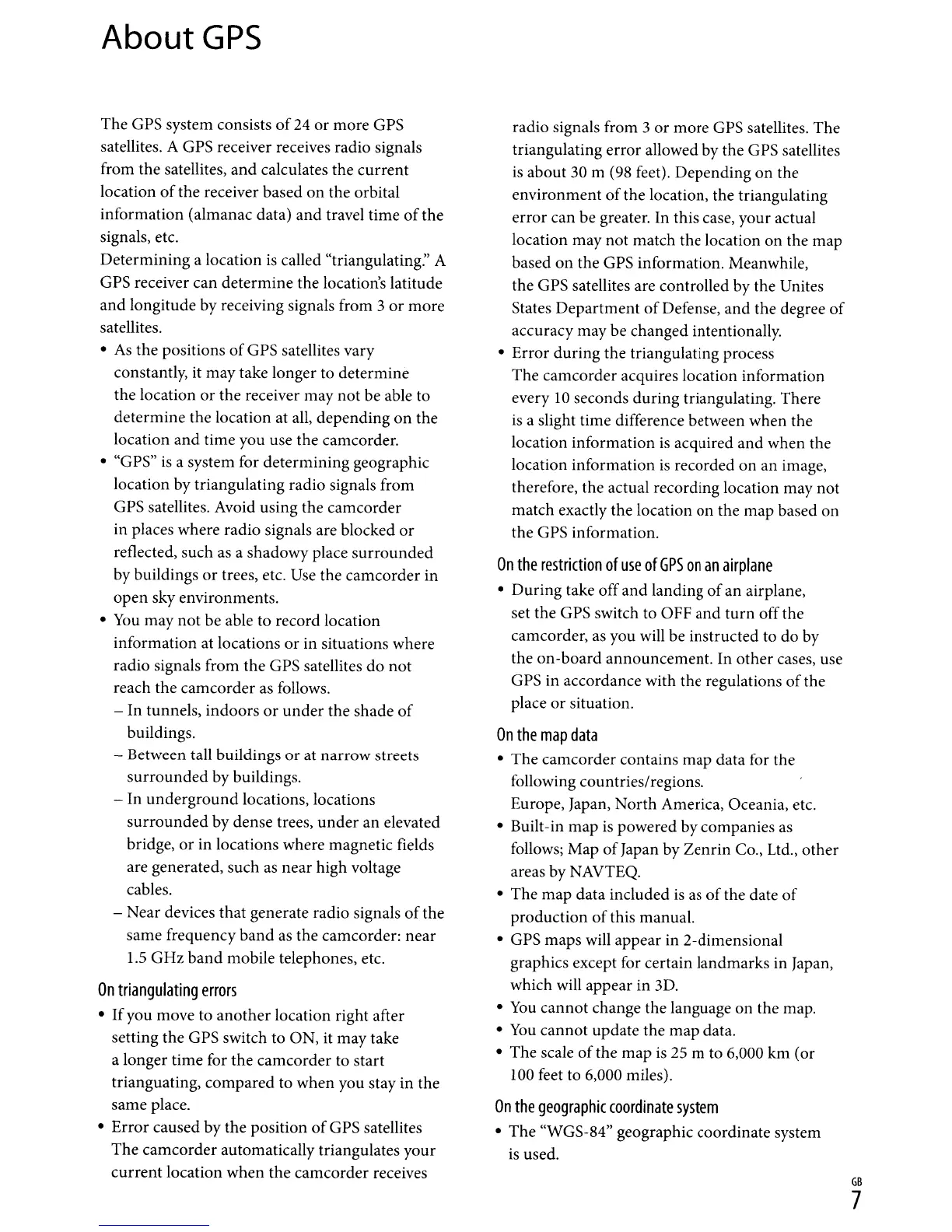About
GPS
The GPS system consists
of
24
or more GPS
satellites. A GPS receiver receives radio signals
from the satellites, and calculates the current
location
of
the receiver based on the orbital
information (almanac data) and travel time
of
the
signals, etc.
Determining a location
is
called "triangulating:' A
GPS receiver can determine the location's latitude
and longitude by receiving signals from 3
or
more
satellites.
•
As
the positions
of
GPS satellites vary
constantly, it may take longer to determine
the location or the receiver may not be able to
determine the location at all, depending
on
the
location and time you use the camcorder.
• "GPS"
is
a system for determining geographic
location by triangulating radio signals from
GPS satellites. Avoid using the camcorder
in places where radio signals are blocked or
reflected, such as a shadowy place surrounded
by buildings
or
trees, etc. Use the camcorder in
open sky environments.
•
You
may not be able to record location
information at locations or in situations where
radio signals from the GPS satellites
do
not
reach the camcorder
as
follows.
- In tunnels, indoors
or
under the shade
of
buildings.
- Between tall buildings or at narrow streets
surrounded by buildings.
- In underground locations, locations
surrounded by dense trees, under an elevated
bridge, or in locations where magnetic fields
are generated, such
as
near high voltage
cables.
- Near devices that generate radio signals ofthe
same frequency band as the camcorder: near
1.5
GHz band mobile telephones, etc.
On
triangulating
errors
•
If
you move to another location right after
setting the GPS switch to ON,
it
may take
a longer time for the camcorder to start
trianguating, compared to when you stay in the
same place.
• Error caused by the position
of
GPS satellites
The camcorder automatically triangulates your
current location when the camcorder receives
radio Signals from 3 or more
GPS
satellites. The
triangulating error allowed
by
the GPS satellites
is
about 30 m (98 feet). Depending on the
environment
of
the location, the triangulating
error can be greater. In this case, your actual
location may not match the location on the map
based
on
the
GPS
information. Meanwhile,
the GPS satellites are controlled by the Unites
States Department
of
Defense, and the degree
of
accuracy may be changed intentionally.
• Error during the triangulating process
The camcorder acquires location information
every
10
seconds during triangulating. There
is
a slight time difference between when the
location information
is
acquired and when the
location information
is
recorded on an image,
therefore, the actual recording location may not
match exactly the location on the map based on
the GPS information.
On
the
restriction
of
use
of
GPS
on
an
airplane
• During take offand landing
of
an airplane,
set the
GPS
switch to OFF and turn offthe
camcorder, as you will be instructed to do by
the on-board announcement. In other cases, use
GPS in accordance with the regulations of the
place or situation.
On
the
map
data
• The camcorder contains map data for the
following countries/regions.
Europe, Japan, North America, Oceania, etc.
• Built-in map
is
powered by companies
as
follows; Map
of
Japan by Zenrin Co., Ltd., other
areas
by
NAVTEQ.
• The map data included
is
as
of
the date
of
production
of
this manual.
• GPS maps will appear in 2-dimensional
graphics except for certain landmarks in Japan,
which will appear in 3
D.
•
You
cannot change the language on the map.
•
You
cannot update the map data.
• The scale
of
the map
is
25
m to 6,000 km (or
100
feet to 6,000 miles).
On
the
geographic
coordinate
system
• The "WGS-84" geographic coordinate system
is
used.
GB
7

